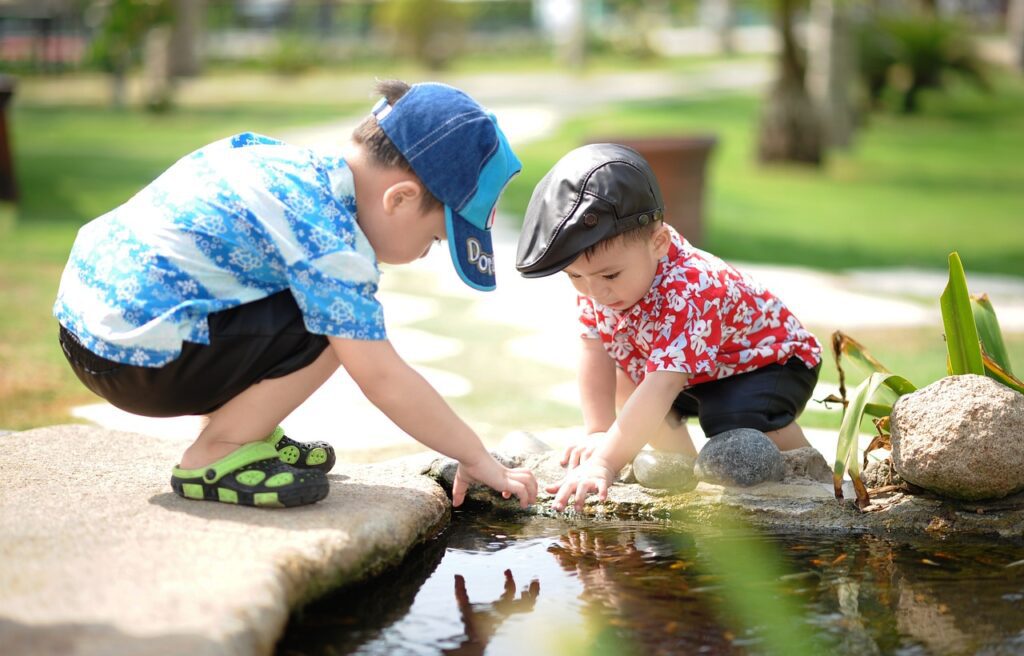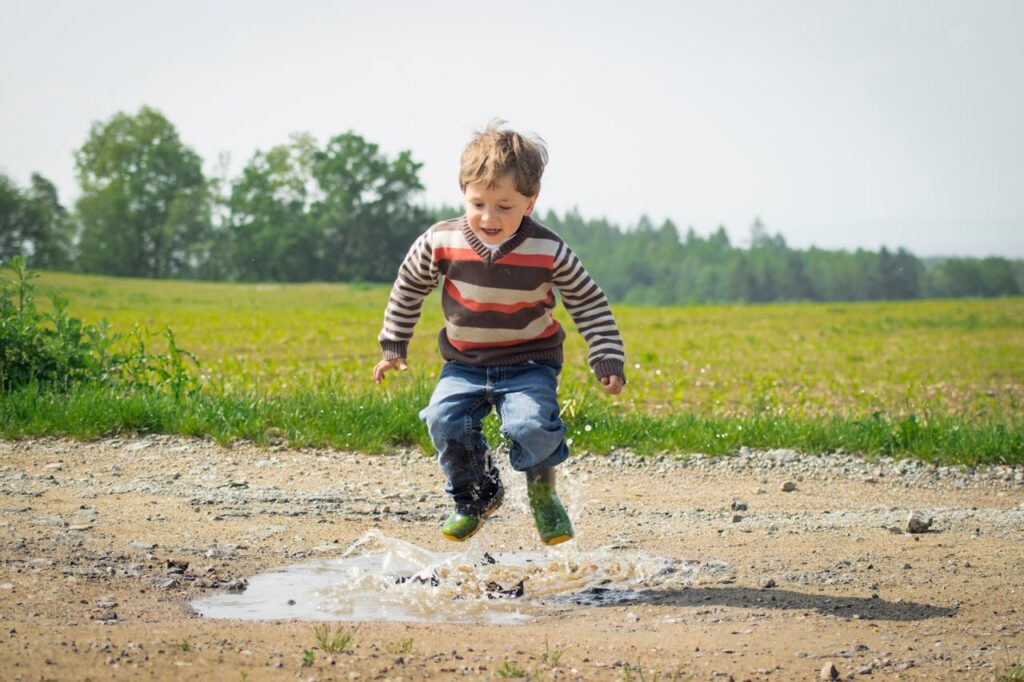
Today’s youth are growing up in a world that is vastly different from the one their parents and grandparents experienced. One of the most significant changes is the amount of time children spend outdoors. In the past, children spent much of their free time playing outside, exploring nature, and engaging in physical activity. However, in recent years, there has been a significant decline in the amount of time children spend in nature, and this has raised concerns about the impact of this trend on their health and well-being.
There are many reasons why children are spending less time in nature. One of the main factors is the increased use of technology. Children today are more likely to spend their free time playing video games, watching TV, or browsing the internet than they are to explore the outdoors. Additionally, many children live in urban areas where access to green spaces is limited. This lack of exposure to nature has led to concerns about the physical, emotional, and mental health of today’s youth.
Historical Context of Nature in Child Development
Evolutionary Perspectives
From an evolutionary perspective, humans have spent the majority of their existence living in close proximity to nature. For tens of thousands of years, humans lived as hunter-gatherers, relying on the natural environment to provide food, shelter, and other resources necessary for survival. As a result, humans have evolved to be intimately connected with nature, and exposure to natural environments has been a critical component of human development for most of our history.
Shifts in Childhood Environments
However, in recent centuries, there has been a significant shift in the environments in which children grow up. With the rise of industrialization and urbanization, more and more children are growing up in urban or suburban environments, with limited access to natural spaces. This shift has been particularly pronounced in the last few decades, with the rise of technology and screen-based entertainment leading to even less time spent outdoors.
This shift has raised concerns among some researchers and child development experts, who argue that exposure to natural environments is critical for healthy child development. Studies have suggested that spending time in nature can have a range of benefits for children, including improved physical health, reduced stress and anxiety, and improved cognitive and social functioning.
Despite these concerns, many children today have limited opportunities to interact with nature on a regular basis. As a result, some experts have called for a renewed focus on connecting children with nature, both through structured programs and activities and through encouraging unstructured play in natural environments
Psychological Impact on Today's Youth
The removal of children from nature has had a significant psychological impact on today’s youth. This section will discuss the cognitive development, emotional, and behavioral consequences that have resulted from the lack of exposure to nature.

Cognitive Development
Studies have shown that exposure to nature can have a positive impact on cognitive development in children. According to a report by the American Psychological Association and ecoAmerica, children who spend time in nature have improved attention spans, better problem-solving skills, and enhanced creativity.
Conversely, children who lack exposure to nature may experience delays in cognitive development. A study published in the Journal of Environmental Psychology found that children who spent less time outdoors scored lower on measures of attention and working memory.
Emotional and Behavioral Consequences
The lack of exposure to nature can also have emotional and behavioral consequences for today’s youth. Children who spend less time in nature may experience higher levels of stress, anxiety, and depression. A study published in the journal Nature Mental Health found that more than half of young people surveyed reported being very or extremely worried about climate change.
Additionally, children who lack exposure to nature may have difficulty regulating their emotions and behaviors. A study published in the Journal of Environmental Psychology found that children who spent more time in nature had better emotional regulation and were less likely to engage in impulsive or aggressive behaviors.
In conclusion, the removal of children from nature has had a significant psychological impact on today’s youth. The lack of exposure to nature has resulted in cognitive delays, emotional stress, and behavioral difficulties. It is essential to prioritize nature-based experiences for children to promote healthy psychological development.
Physical Health Implications
Activity Levels and Obesity
The lack of exposure to nature has been linked to decreased physical activity levels and increased obesity rates among children. A study published in the International Journal of Environmental Research and Public Health [1] found that children who spent more time outdoors engaged in more physical activity and had lower body mass indexes (BMI) than those who spent less time outdoors.
Furthermore, the prevalence of sedentary activities, such as watching television and playing video games, has increased with the decrease in outdoor playtime. The American Heart Association recommends that children engage in at least 60 minutes of moderate to vigorous physical activity each day, which can be difficult to achieve without access to outdoor spaces.
Nature Deficit Disorder
The term “Nature Deficit Disorder” was coined by Richard Louv in his book “Last Child in the Woods” [2]. It refers to the negative consequences of a lack of exposure to nature, including physical and mental health problems.
Studies have shown that spending time in nature can decrease stress levels and improve mental health outcomes [3]. Children who have limited access to nature may experience higher levels of stress and anxiety, which can lead to a variety of health problems.
In conclusion, the lack of exposure to nature can have significant physical health implications for children, including decreased physical activity levels and increased obesity rates. Additionally, the negative consequences of a lack of exposure to nature can extend to mental health outcomes, leading to higher levels of stress and anxiety.
References:

Social and Emotional Skills
Empathy and Relationships
Studies have shown that children who spend time in nature tend to have better social and emotional skills. According to a research article on Children and Nature, children who have a strong connection to nature have higher social-emotional learning skills than those with a weaker connection. This includes empathy, communication, and relationship-building skills. Spending time in nature helps children develop a sense of connectedness to the world around them, which can lead to greater empathy and understanding of others.
Risk-Taking and Independence
Spending time in nature can also help children develop important skills related to risk-taking and independence. According to an article on EdWeek, technology can have a negative impact on children’s social skills, but social-emotional learning can help support healthy tech use. Additionally, spending time in nature can help children learn to take risks in a safe and controlled environment, which can lead to greater independence and confidence in their abilities.
In summary, spending time in nature can have a positive impact on children’s social and emotional development. It can help them develop important skills related to empathy, communication, relationship-building, risk-taking, and independence.
Homeschooling allows for a tailored curriculum that is specifically designed to meet the needs of each individual child. This is in contrast to the public school system, which often uses a one-size-fits-all approach to education. With homeschooling, parents have the freedom to choose the curriculum that best suits their child’s learning style, interests, and abilities.
Educational Outcomes
Outdoor Learning Benefits
Studies have shown that outdoor learning can have a positive impact on educational outcomes. According to a study published in Nature, outdoor learning can improve academic performance, increase engagement, and reduce stress levels in students. Additionally, outdoor learning has been found to improve social skills, teamwork, and problem-solving abilities in children [1].
Furthermore, outdoor learning can help children develop a deeper appreciation for the natural world and may even encourage them to pursue careers in environmental science or conservation. However, it is important to note that not all schools have access to outdoor learning opportunities, and low-income and minority students are often disproportionately affected by this lack of access [3].
Attention and Motivation
In addition to improving academic performance, outdoor learning may also have a positive impact on attention and motivation. A study published in Frontiers in Psychology found that children who spent time in nature had improved attention and cognitive functioning compared to those who spent more time indoors [2].
Moreover, outdoor learning can help children develop a sense of wonder and curiosity about the world around them, which can lead to increased motivation to learn. By incorporating nature-based learning activities into the curriculum, educators can create a more engaging and stimulating learning environment for their students.
In conclusion, outdoor learning can have numerous benefits for educational outcomes, particularly in terms of academic performance, attention, and motivation. However, it is important for schools to ensure that all students have access to these opportunities, regardless of their socioeconomic background.
References:
Does environmental education benefit environmental outcomes in children? A systematic review and meta-analysis. ScienceDirect. https://www.sciencedirect.com/science/article/pii/S0272494422000275
The Cognitive Benefits of Interacting With Nature. Frontiers in Psychology. https://www.frontiersin.org/articles/10.3389/fpsyg.2018.00777/full
Enhancing Educational and Environmental Awareness Outcomes Through Nature-based Programming. SAGE Journals. https://journals.sagepub.com/doi/full/10.1177/16094069211016719
Technological Substitutes for Nature
Virtual nature experiences, such as videos, live webcams, and immersive virtual environments, are becoming increasingly popular as a way to connect with nature. While these experiences can offer some benefits, they cannot replace the physical and emotional benefits of spending time in nature.
Research has shown that engagement with technological nature may be better than no nature, but there are real concerns about using it as a replacement for engagement with real nature. While virtual nature experiences can be a useful tool for education and research, they should not be relied on as a substitute for real-world experiences.
In conclusion, while technological substitutes for nature can offer some benefits, they cannot replace the physical and emotional benefits of spending time in nature. Children should be encouraged to spend more time outdoors in nature and to develop a connection with the natural world. Virtual nature experiences can be a useful tool for education and research, but they should not be relied on as a substitute for real-world experiences.
Virtual Nature Experiences
Children are spending more time in front of screens than ever before. This has led to concerns about the impact of screen time on physical and mental health, as well as the development of social skills. While some studies have shown that screen time can have a negative impact on children’s health and well-being, others have suggested that it may not be as harmful as previously thought.
Green time, on the other hand, refers to the time spent outdoors in nature. This has been shown to have numerous benefits, including reduced stress, improved mental health, and increased physical activity. Children who spend more time in nature are also more likely to develop a connection with the natural world, which can lead to a greater appreciation for the environment and a desire to protect it.
The Last Child in the Woods by Richard Louv

In his book “Last Child in the Woods,” Richard Louv argues that children’s lack of nature exposure, which he calls “nature-deficit disorder,” is linked to some of the most disturbing childhood trends, such as the rise in obesity, attention disorders, and depression. He believes that children need to spend more time in nature to develop their creativity, imagination, and sense of wonder.
Louv cites several reasons for the decline in children’s nature exposure, including urbanization, the increase in screen time, and parental fears of strangers and accidents. He argues that parents and educators need to make a conscious effort to reconnect children with nature by providing them with opportunities to explore and play in natural environments.
How Compulsory Education Is Preventing Children Access to Nature
Louv also criticizes the education system for prioritizing academic achievement over outdoor play and hands-on learning. He argues that standardized testing, homework, and extracurricular activities leave little time for children to engage with nature and learn through experience.
Louv suggests that schools should incorporate more outdoor education and environmental literacy into their curriculum, and that teachers should use natural environments as a teaching tool. He believes that by integrating nature into education, children will be better equipped to understand and appreciate the natural world, and will be more motivated to protect it.
Overall, Louv’s book “Last Child in the Woods” highlights the importance of nature for children’s physical, emotional, and cognitive development. He encourages parents, educators, and policymakers to prioritize nature exposure for children and to recognize the value of outdoor play and learning.
Policy and Community Initiatives
Educational Reforms and Outdoor Programs
Many educational institutions have recognized the importance of connecting children with nature and have made efforts to incorporate outdoor programs into their curriculum. For instance, some schools now offer outdoor classes, nature-based kindergarten, and field trips to natural areas. These outdoor programs help students develop an appreciation for nature and the environment, as well as provide opportunities for physical activity and hands-on learning experiences.
In addition, some educational reforms have been implemented to promote outdoor learning. For example, in 2018, the Finnish government introduced a new national curriculum that emphasizes the importance of outdoor education. The curriculum mandates that all students in Finland must spend at least one hour outside every day, regardless of the weather conditions. This initiative has been successful in improving children’s physical and mental health, as well as their academic performance.
Homeschool Students Have More Access to Nature
Homeschooling is becoming increasingly popular in the United States, with over 2.5 million children currently being homeschooled. Homeschooling parents have the flexibility to incorporate outdoor education into their children’s curriculum and can take advantage of the natural resources in their local communities. Homeschooling also allows for more personalized learning experiences and can be tailored to meet the individual needs and interests of each child. The number of creative outdoor learning experiences is rapidly expanding. From farm schools, to park schools, and beach schools, homeschool students have so many options to learn in nature and learn through nature.
Many homeschooling families participate in nature-based programs and outdoor activities, such as hiking, camping, and gardening. These experiences provide children with opportunities to develop a deep connection with nature and learn about the environment in a hands-on way. Homeschooling also allows for more time spent outdoors, as children are not constrained by the time limitations of a traditional school day. Designing an educational plan to ensure nature exposure and experiences enriches the schooling experience for every child.
Overall, policy and community initiatives as well as the increase of homeschooled children have played an important role in promoting outdoor education and providing children with opportunities to connect with nature. These initiatives combined with homeschooling have helped to address the negative impacts of removing children from nature and have provided children with the tools and knowledge to become stewards of the environment.
